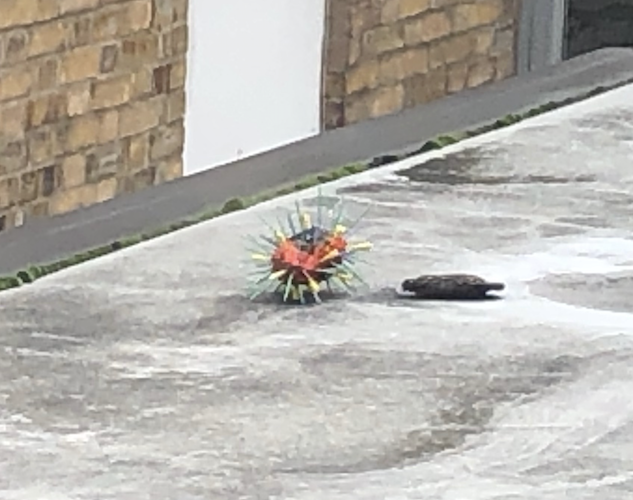Anyone who travelled on the top deck of a bus in north east London between around 2007 and 2011 could not have helped but notice an odd phenomenon. Sat atop dozens of bus shelters, particularly in Hackney, but also as far afield as Lambeth, Newham and Camden, were odd spherical objects with dayglo spikes of many colours protruding from them.
I didn’t particularly notice them at first. They were but one of the many types of object that made appearances on bus shelter roofs. There were little toadstools and even, for a while, pieces of turf in the shape of letters, most of which rapidly dried out in the sun or turned to puddles of sludge in the rain. There were other projects too, most of them long forgotten. But for a short time around the turn of the decade, bus shelters became galleries for unofficial public art projects of varying quality and success.
But none were as ubiquitous or were established for as long as what came to be known as Spiky Spuds. It took some fairly furious googling to find out what these alien-looking creatures were. It had genuinely never occurred to me that what I was looking at were potatoes (though perhaps this explained why they seemed to get smaller over time). The spikes protruding from them were either cocktail sticks or cotton buds dipped in neon paint.
Who was behind this endeavour? Why did they do it? How far from Hackney could a Spiky Spud be found? Were they all created by the same person, or had there been a rash of copycats? Above all, how the hell did they get them up there? The roof of a bus stop is way beyond the reach of all but the very tallest Londoners, yet the objects seemed so undamaged and carefully positioned it seemed unlikely someone had simply hurled a cocktail stick festooned tuber up there and hoped for the best. Was a wannabe Banksy touring London with a stepladder and a sack full of spray painted Maris Pipers and, if so, how come were they never caught?
But then, one day, it all stopped. Not a noticeable, sudden stop, more a tailing off in their deployment, as growing numbers of surviving Spikys shrivelled from view, were blown away in a gale, or were removed by a Transport for London worker tasked with keeping London’s bus route infrastructure free of creative detritus.
London is a city defined by its perpetual movement and change. For good or for ill, nothing ever stays the same for long, no matter how much we might want it to. Places and faces change. People move on, or move out. It seemed safe to assume that the Spiky Spud maker had done the same: had had kids; been priced out; started a new life in the Med; settled down in a Bromley semi. It took me a while to notice their disappearance – I think the wizened remains of a Spiky near Newington Green in late 2012 was what made me realise that something was amiss – but after a long and distinguished run, the Spiky Spuds were gone.
And then, a surprise. One day, burdened with more luggage than usual on my morning commute, I caught the 254 to work rather than squeeze on to a train. Staring blankly out of the window somewhere along Cambridge Heath Road I saw what was unmistakably a Spiky Spud. I tried to grab a photo of it, but my phone wouldn’t kick into gear quickly enough. I feared my opportunity to capture evidence of the phenomenon’s return, perhaps a tribute act from a late noughties nostalgist, had slipped away. But the next bus shelter roof had two of them, and there were several more along the same stretch of the route.
To most, the return of east London’s luminous bus stop potatoes is at most a curio, much like their arrival in the first place. But there is a little more to it than that. All of us cling to the lie of permanence to try to make sense of the world. We do the same things in the same places with the same people at the same time of year to create the illusion that nothing will ever change. That we’ll never get old. That the people and places we treasure will always be there for us to take comfort in. Nowhere is this illusion so frequently and brutally broken as in London, where the only permanence to be found is the constantly shifting sands.
And so there is, oddly, some comfort to be drawn from the return of this longitudinal study in weirdness. Long live the Spuds. May they always grace London’s bus network. The Spiky Spudder moves amongst us still, resisting the temptation or compulsion to start a new life somewhere else, where the project simply wouldn’t make any sense – if it ever did.
Patrick Moûle is the man on the Hackney omnibus. He tweets here. Photograph from top deck of 254 along Cambridge Heath Road by Dave Hill.
OnLondon.co.uk is dedicated to providing fair, thorough and resolutely anti-populist coverage of London’s politics, development and culture. It depends on donations from readers and would like to pay its freelance contributors better. Can you spare £5 a month (or more)? Follow this link to donate. Thank you.

